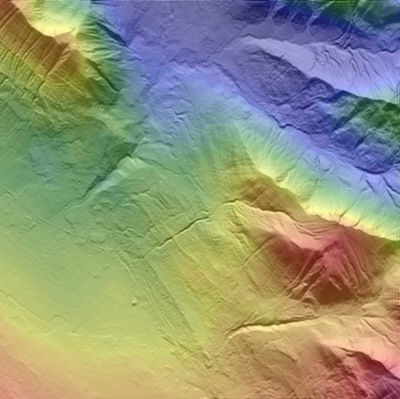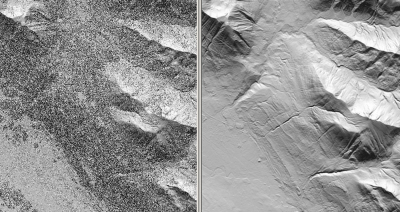
Scanning LiDAR for Terrain Mapping
Sander Geophysics Ltd (SGL) provides terrain mapping
services using a sophisticated airborne scanning LiDAR
(Light Detection and Ranging) system, which collects data
along a swath below the aircraft flight path, using a
Riegl LMS-Q280i airborne laser scanner. The scanning
LiDAR data are geometrically corrected with accurate GPS
location, and pitch, roll and yaw determinations.
Other geophysical information, such as AIRGrav or
aeromagnetic data, is collected simultaneously using SGL´s
fixed-wing and helicopter platforms. The scanning LiDAR
system allows SGL to produce high resolution digital
terrain models which can be used for environmental
assessment, geotechnical and engineering applications as
well as gravity terrain corrections. SGL has used laser
scanner data since 1998 in order to provide its clients
with the most accurate terrain elevation data possible.
The laser wavelength of SGL's scanning LiDAR system is
near infrared and the scanning mechanism is a rotating
polygon mirror which provides the laser measured distance
and the 24-bit RGB colour of the target's surface. This
allows SGL to provide a digital colour image of the ground
surface along with the digital elevation model, and any
other geophysical data collected.
The GPS position recovery uses NovAtel dual frequency
receivers in the aircraft and on the ground, processed
using SGL's proprietary GPSoft processing system,
resulting in a horizontal position accuracy of better than
0.2 m and a vertical position accuracy of better than 0.3
m.
The aircraft attitude (pitch, roll, and yaw) can be
provided using SGL's AIRGrav system at a data rate of 128
samples per second, and an accuracy of better than 0.5
arcmin for pitch and roll measurements and 1.0 arcmin for
yaw.

Figure 1: Scanning LiDAR
digital terrain model with magnetic data superimposed
A "bare-earth" digital terrain model, in which the
effects of vegetation are removed, can be generated
through the application of an iterative process. An
example is shown below.

|
Figure 2(a): Scanning
LiDAR digital terrain model before tree removal
|
Figure 2(b): Scanning
LiDAR digital terrain model after tree removal
|
|